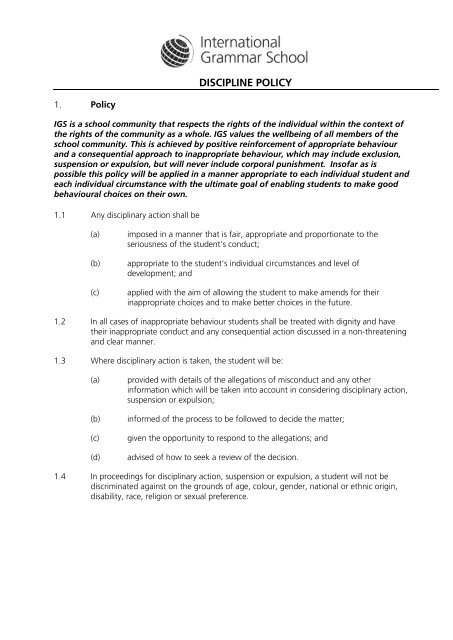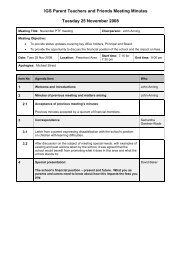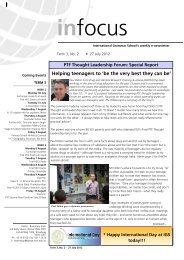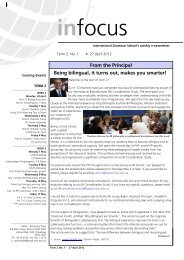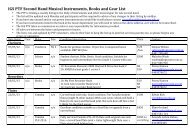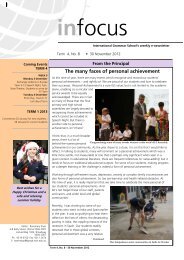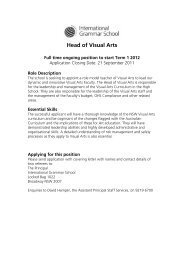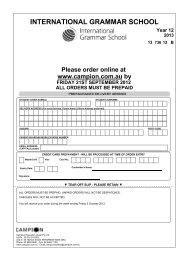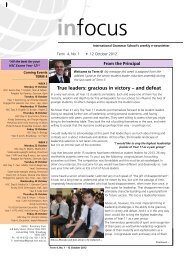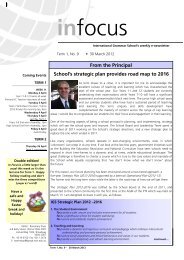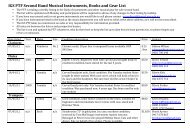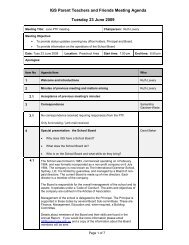DISCIPLINE POLICY (including Suspension & Expulsion)
DISCIPLINE POLICY (including Suspension & Expulsion)
DISCIPLINE POLICY (including Suspension & Expulsion)
Create successful ePaper yourself
Turn your PDF publications into a flip-book with our unique Google optimized e-Paper software.
<strong>DISCIPLINE</strong> <strong>POLICY</strong>1. PolicyIGS is a school community that respects the rights of the individual within the context ofthe rights of the community as a whole. IGS values the wellbeing of all members of theschool community. This is achieved by positive reinforcement of appropriate behaviourand a consequential approach to inappropriate behaviour, which may include exclusion,suspension or expulsion, but will never include corporal punishment. Insofar as ispossible this policy will be applied in a manner appropriate to each individual student andeach individual circumstance with the ultimate goal of enabling students to make goodbehavioural choices on their own.1.1 Any disciplinary action shall be(a)(b)(c)imposed in a manner that is fair, appropriate and proportionate to theseriousness of the student’s conduct;appropriate to the student’s individual circumstances and level ofdevelopment; andapplied with the aim of allowing the student to make amends for theirinappropriate choices and to make better choices in the future.1.2 In all cases of inappropriate behaviour students shall be treated with dignity and havetheir inappropriate conduct and any consequential action discussed in a non-threateningand clear manner.1.3 Where disciplinary action is taken, the student will be:(a)(b)(c)(d)provided with details of the allegations of misconduct and any otherinformation which will be taken into account in considering disciplinary action,suspension or expulsion;informed of the process to be followed to decide the matter;given the opportunity to respond to the allegations; andadvised of how to seek a review of the decision.1.4 In proceedings for disciplinary action, suspension or expulsion, a student will not bediscriminated against on the grounds of age, colour, gender, national or ethnic origin,disability, race, religion or sexual preference.
2. Expectations of Behaviour2.1 Students are required to:(a)(b)(c)(d)utilise the IGS Common Courtesies;abide by the IGS Code of Behaviour in their dealings with each other andother members of the school community;follow the directions of teachers and other people with authority delegated bythe school; andcomply with all other IGS rules and regulations.2.2 Students may expect:(a)(b)that the IGS Common Courtesies will be used by others in their dealings withthem; andto receive encouragement and positive reinforcement when they make aneffort to engage in appropriate behaviour or demonstrate a willingness toremedy inappropriate behaviour and make better behavioural choices in thefuture2.3 The IGS Code of Behaviour (School Rules) was developed by students as a way ofencouraging mutual rights and responsibilities:(a)(b)(c)(d)(e)(f)(g)(h)(i)(j)Wear your uniform correctly;Be kind, considerate, courteous and accepting of others;Keep the school clean and pleasant;Respect others’ property;Keep yourself and others safe;Be honest and trustworthy;Respect everyone’s right to learn;Be in the right place at the right time;Make the most of your opportunities; andKeep the school’s reputation high.2.4 The Code of Behaviour (School Rules) and IGS Common Courtesies are found at thefront of the School Diary used by students in Year 3-12, in the Staff Handbook and areposted in developmentally appropriate formats in classrooms across the school.2.5 Other rules and regulations of the school are to be found in the School Diary, on theSchool website and as issued from time to time.2
3. Procedures for Non-Compliance3.1 Serious inappropriate behaviour will include, but is not limited to, breaches ofparagraph 2.1 above in which a student:(a)(b)(c)is persistently disobedient or persistently insolent;engages in harassment and abuse of other students or staff;persistently disrupts and prevents the learning and teaching of others;(d) engages in violent* behavior (see Appendix 2)(e)(f)(g)in possession of a prohibited weapon/firearm or drugs at school;engages in criminal behaviour related to the school; orcauses a risk to the health, safety or wellbeing of other students, staff orvisitors to the school.*Violence does not have to be intentional to give rise to risks and can include:(i)(ii)(iii)(iv)any behavior that seriously interferes with the physical and psychological health,safety and wellbeing of staff, students and/or others who may be at a school;seriously inappropriate sexual behavior that could cause physical andpsychological harm to the reasonable person;serious and credible threats to commit violence;verbal abuse of others on the grounds of any personal characteristic protected bythe Anti-Discrimination Act 1977 (such as race, gender, sexuality and othercharacteristics) that could cause physical or psychological harm to the reasonableperson.3.2 Teachers will deal with misbehaviour by a student that is not serious inappropriatebehaviour in accordance with paragraphs 1.1 - 1.3 above. In the event that a studentwishes to seek review of a teacher's decision in this regard, that matter will be referredto the Head of Department, Head of Subject, an Assistant Principal or Deputy Principal asappropriate .3.3 In cases of serious inappropriate behaviour by a student, the teacher will refer thematter to an Assistant Principal or the Deputy Principal as appropriate for further action.3.4 An Assistant Principal or the Deputy Principal will make a preliminary assessment of thesituation which they will communicate to the student and their parents and/or guardianswho will then be given the opportunity to respond. A final decision will then be made asto the appropriate action to be taken.3.5 In the event that a student wishes to seek review of the decision of an Assistant Principalor the Deputy Principal, the matter will be referred to the Principal who may, at his or herdiscretion, review the matter solely or convene a committee of his or her own size andchoosing to review the matter. The decision of the Principal in respect of a review shallbe final.3.6 If the matter is ultimately referred to the Principal (or in their absence, the DeputyPrincipal) the following may occur:3
(a)(b)if a student's behaviour is a risk to the health and safety or wellbeing of otherstudents, staff or visitors to the school then the student may be excluded(short term) from the school or activity. The Principal may require an externalassessment prior to the student's return to the school or activity. The School'sDiscipline Policy will remain in place and appropriate sanctions andpunishments may be given; and/orif the Principal considers that the student should be suspended or expelled, theIGS suspension and expulsion policy must be followed.4
Appendix 1: <strong>Suspension</strong> and <strong>Expulsion</strong>1. PolicyThe School Principal may, suspend or, in conjunction with the Board, expel, a student fromthe school for serious inappropriate or violent behaviour.<strong>Suspension</strong> allows a student time to reflect on their behaviour, to acknowledge and acceptresponsibility for that behaviour, and to change their behaviour in the future. It also allowstime for the school to plan appropriate support for the student to assist with successful reentry.In cases where this is not possible, or the conduct in question is sufficiently serious from theoutset, then the student will be expelled.1.1 <strong>Suspension</strong> is the temporary removal of a student from all classes that he or she wouldnormally attend at the school, for a set period of time.1.2 <strong>Expulsion</strong> is the permanent removal of a student from the school.1.3 The school's approach to serious inappropriate or violent behaviour, (as described atparagraph 3.1 of the IGS Discipline Policy) that warrants suspension and/or expulsionshall be a collaborative approach between the school, the student and their parents orand/or guardians.1.4 Paragraphs 1.1 - 1.4 of the IGS Discipline policy will be applied.1.5 All suspensions shall be recorded in a <strong>Suspension</strong> Register and all relevant documentationshall be retained on a file at the school,2. <strong>Suspension</strong>2.1 Considerations for <strong>Suspension</strong>(a)(b)(c)(d)(e)In determining whether a student’s behaviour is serious enough to warrantsuspension, the Principal will consider the safety and welfare of the student,staff and other students in the class or school.The full range of school student welfare and discipline strategies will havebeen implemented, in most cases, before a suspension is imposed and inparticular the student, parents and/or guardians will have been given theopportunity to respond to the allegations of inappropriate behaviour.In some circumstances the Principal may determine that a student should besuspended immediately. This will usually be due to reasons such as the safetyof students or staff because of violence, threats of violence, the presence ofweapons or illegal drugs.A police investigation of a student’s behaviour does not remove the Principal’sdiscretion, to deal with the behaviour as a school disciplinary matter.The Principal may impose either a short suspension of a few school days (lessthan a week) or a long suspension of up to and <strong>including</strong> 20 school days.2.2 Short suspension(a)In cases of short suspension from the school, a resolution meeting shall beheld with the student and their parents and/or guardians, following the5
suspension to discuss the basis on which the suspension will be resolved. Thekey features of the interview will be taken down in writing.(b)If the serious inappropriate behaviour persists after two short suspensions,strategies such as further short suspensions, a longer suspension or alternativeprogrammes maybe arranged depending on the circumstances of eachindividual case2.3 Long <strong>Suspension</strong>(a)(b)(c)(d)(e)If short suspensions have not resolved the problem, or the inappropriatebehaviour is so serious as to warrant a long suspension, the Principal mayimpose a long suspension.The School Board must be notified immediately of any proposed longsuspension.In cases where consideration is being given to imposing a long suspensionfrom the school, a formal disciplinary interview shall be held with the studentand their parents and/or guardians prior to making the decision to suspend.The key features of the interview will be taken down in writing.The Principal shall ensure all available resources are utilized to enable thestudent to return to school following the suspension. The aim is to minimizethe number of days each student is suspended. A report from the schoolcounselor may be appropriate.The Principal shall convene a suspension resolution meeting with the studentand their parents and/or guardians at the earliest opportunity after thesuspension has commenced to discuss the basis on which the suspension willbe resolved. The key features of the meeting will be taken down in writing.2.4 Deciding on a <strong>Suspension</strong>The decision to suspend must be taken by the Principal, or, in the Principal’s absence, theDeputy Principal.2.5 Notifying a <strong>Suspension</strong>(a)(b)(c)(d)A student will not be sent out of school before the end of the school daywithout notification being made to a parent and/or guardian and, if necessary,agreement reached about arrangements for the collection of the child fromschool.Notification of suspension must be made to parents or caregivers in writing.Reasonable steps must be taken to ensure that the notification is received, ifnecessary by alternate or multiple forms of delivery.In all cases, the notification must include:(i)(ii)(iii)Notice of the suspensionThe date and probable duration of the suspension;The reasons for the suspension;6
(iv)(v)The clear expectation that the student will continue with studieswhile suspended and in the case of a long suspension that a studyprogramme will be provided;Other appropriate agencies available to provide assistance wherenecessary;The notification will also stress:(vi)(vii)The importance of parental assistance in resolving the matter;Parental responsibility for the care and safety of the student whileunder suspension.(e)If consideration is being given to proceeding to expulsion from the School thenotification of suspension or formal warning should make this intention plain.2.6 Meetings regarding <strong>Suspension</strong>(a)(b)Should a parent or guardian require a support person in order to participatefully in a disciplinary interview or suspension resolution meeting, a personacceptable to both the parent or guardian and the Principal may be involved.The school will establish any need for parents or caregivers to be provided withinterpreter services for disciplinary interview or suspension resolution meetingsand make arrangements for such services to be available.3. <strong>Expulsion</strong>3.1 When considered necessary, a student may be expelled from the school. The Principalshall notify the School Board immediately of a proposed expulsion. The School Boardshall be consulted on all expulsions.3.2 The Principal will ensure, except as a result of a most serious incident, that all appropriatestudent welfare strategies and discipline options have been implemented anddocumented prior to expelling a student from the school because of inappropriatebehaviour.3.3 When considering whether to expel a student from the school the Principal must:(a)(b)(c)Place the student on a long suspension pending the outcome of the decisionmakingprocess. This action should be taken irrespective of any action byanother agency, <strong>including</strong> the NSW Police Service;notify the student and the parents and/or guardians, in writing, that expulsionfrom the school is being considered, giving reasons for the possible action andallowing seven school days for the student, parents and/or guardian torespond;consider any response from the student or parents and/or guardians beforeproceeding further.3.4 If, having completed the action outlined above, the Principal, in consultation with theSchool Board, decides to expel a student from the school, the Principal must provideformal notification to the student and the parent and/or guardian.7
Appendix 2: Violent BehaviourViolent behavior poses a risk to a school and to the staff, students and others within the school.“Violence” is not restricted to physical acts. For example, aggressive and persistent verbal bullyingmight place individuals at risk of psychological harm; this is considered violent for the purposes ofimplementing procedures for non-compliant behavior at IGS.Violence does not have to be intentional to give rise to risks and can include:1. Any behavior that seriously interferes with the physical or psychological health, safety andwellbeing of staff, students and/or others who may be at a school site or event;2. Seriously inappropriate sexual behavior that could cause physical or psychological harm tothe reasonable person;3. Serious and credible threats to commit violence;4. Verbal abuse of others on the grounds of any personal characteristic protected by the Anti-Discrimination Act 1977 (such as race, gender, sexuality and other characteristics) thatcould cause physical or psychological harm to the reasonable person;5. Aggressive behavior which is non-contact in nature and persistently6. Aggressive or abusive language directed to staff, students or others; and7. Physical damage to property or the learning environment (where such conduct may causethose present to fear harm).Some examples of incidents of serious inappropriate or violent behavior that may lead toprocedures for non-compliance commencing include:1. Physical attacks (for example, punching, hitting, kicking, biting, pinching, hair pulling,scratching or spitting);2. Carrying a prohibited weapon, firearm or knife;3. Grabbing someone’s breast or buttocks without consent;4. Attacks using an implement such as scissors or pens;5. Throwing projectiles in a way that deliberately or recklessly causes physical harm (not<strong>including</strong> participation in sporting matches played according to the rules);6. Physical aggression or violence towards animals and the physical surroundings such as theschool’s plant life and infrastructure; and7. Self-harming behaviours.Other behaviours that could cause psychological harm to the reasonable person that may beidentified as inappropriate may include:1. Persistent verbal bullying <strong>including</strong> repeated use of statements intended to humiliate and/orprovoke another to an act of violence;2. Damage to information technology systems;3. Repeated sexual harassment or use of racist, sexist or homophobic language or languagemocking the disability of a student, member of staff or visitor to a school;4. Written abuse <strong>including</strong> writing threatening or abusive letters, graffiti targeting individualsor particular groups, bullying or harassment using text messages or email, posting oninternet sites, making inappropriate videos, photographs or sound recordings and/orsharing or texting them and posting them on websits;5. Threats and intimidation;6. And physical and technological stalking.Self harming behavior poses a potential risk to the individual student and to those who mightwitness self-harming behavior and can pose a risk of psychological injury to other students,particularly if they are young and vulnerable, or to staff.8


